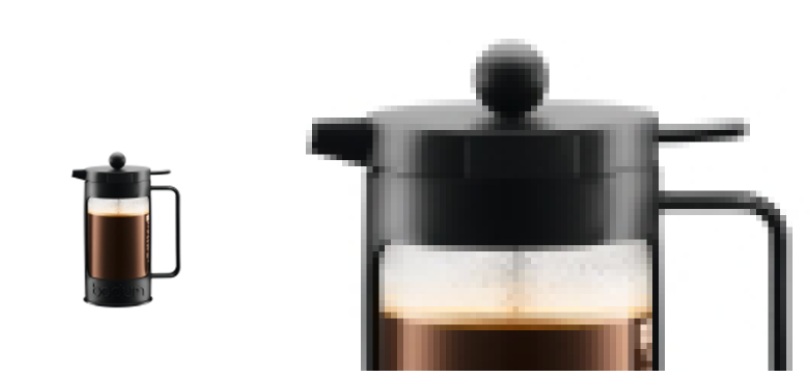RESOLUTION and IMAGE SIZE
Posted in: Industry News
A lot of people out there aren’t sure what has to happen once they hand a file over to us. There are a number of factors out there when it comes to giving us a file we can actually use. I would like to give you a simple example of a problem file.
First off, lets talk about two really important factors an image file contains….RESOLUTION and IMAGE SIZE.
RESOLUTION and IMAGE SIZE are two factors that can limitate our ability to ‘blow a photo up’ with out the photo pixilizing. Pixilizing occurs when the individual pixels are too large (or not enough pixels) to ‘spread out,’ and thus, when the resolution is too low, it will create a blurred, blocky, ugly version when sized larger. This pixilization can also happen because the picture is simply too small to blow up…check out the example below.

The coffee press photo on the left came from their website. There are many instances when customers will show us a website with their logo, or hand us a business card, and the image they want us to reproduce has the same quality as the coffee press. They want them blown up 10 times larger. Long story short, it isn’t possible. Here are the facts about this image.
First off, the size of this coffee press image is a grand total of 1.8″ x 1.8″. This is the case with most of the images on the internet, THEY ARE SMALL. To add to this problem, this images resolution is a grand total of 72 DPI (Dots per inch). The image on the right shows what happens when you try to blow it up in size….it pixilizes and looks ugly.
One way to stop this is two fold. One, start with a larger image, say 18″ x 12″…and the image resolution of the image needs to be in the 300 DPI range. When this is true, there is a lot more flexibility as to what we can do with an image. Check out the example below:
 Notice the small blown up part of the ‘a’ above the photo is. That is magnified almost 600%, and you just start noticing pixilizing. This is the type of image you would want to hand to us if you want it sized larger. The image contains enough pixels to handle being manipulated. I could probably blow this picture up double or maybe more before noticing pixilizing.
Notice the small blown up part of the ‘a’ above the photo is. That is magnified almost 600%, and you just start noticing pixilizing. This is the type of image you would want to hand to us if you want it sized larger. The image contains enough pixels to handle being manipulated. I could probably blow this picture up double or maybe more before noticing pixilizing.
This gleams a little insight as to what you need to bring us to warrant a certain result. In the next few weeks, I’ll dive into the different file formats that are available and the one’s we like the best.
Hope you learned something today!
Return to: RESOLUTION and IMAGE SIZE
Social Web